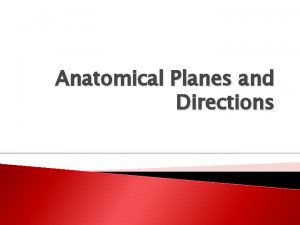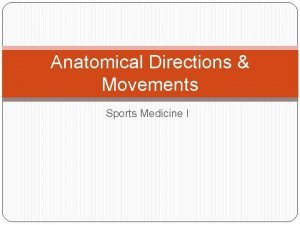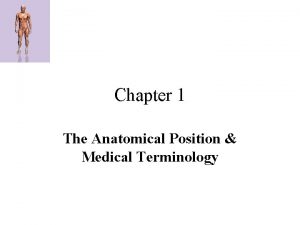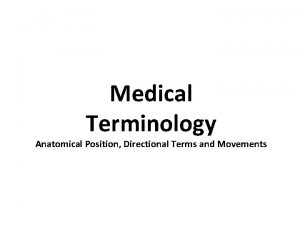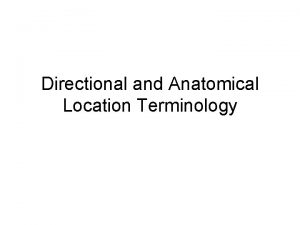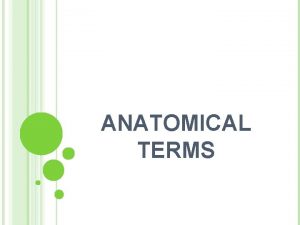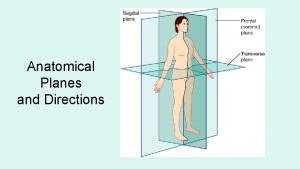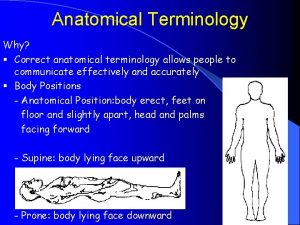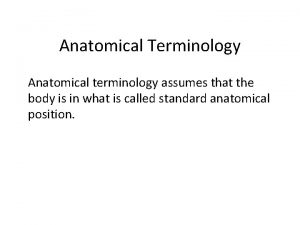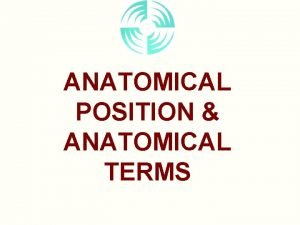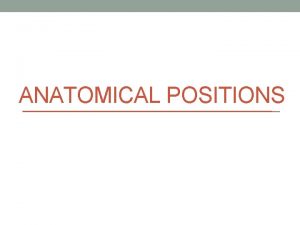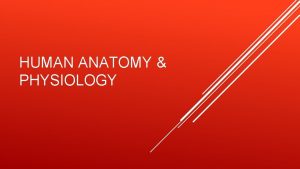Intro to anatomy and physiology Anatomical terminology directions












- Slides: 12

Intro to anatomy and physiology Anatomical terminology, directions, and body planes.

What’s the difference? • Anatomy-The study of the form of the human body. • Developmental anatomy-Focuses on how the individual forms from a fertilized egg all the way through adulthood. • Gross anatomy-Study of the large parts of the body that can be seen with the naked eye. (not named gross because it’s all blood and guts, grosse in french means ‘large’). This is what this class will mostly consist of. • Histologic anatomy-Study of tissue types and the cells that make them up.

What’s the difference? • Physiology-The study of the function of the human body. • Physiology looks at how all the different body systems work together to perform a single function. Ex. If you pull your hand away from a hot stove, you’re using the muscles in your hands and arms to pull away as well as the function of the brain and nerves to tell you the stove is hot.

Levels of the body • Atoms-smallest piece of an • • • element (ex. oxygen, carbon, nitrogen, and sodium) Molecule-formation of atoms (ex. Water, sodium chloride, proteins, carbohydrates, and lipids) Cells-formation of molecules, “the fundamental unit of life. ” ex. Nerve cells, muscle cells, and blood cells. Tissues-collection of like cells in an area. 4 types: epithelial (skin), connective (blood/bone), muscle, and nerve. Organs-two or more tissues working together Organ system-two or more organs working together Organism-a collection of organ systems working together to perform a function

Organ systems in the human body Organ system • • • Integumentary Skeletal Nervous Endocrine Muscular Digestive Respiratory Circulatory Immune Urinary Reproductive Physiological role • • • Covers the body and protects it Protects body/provides support Coordinates body functions Uses chemicals to perform functions Permits body movements Digest food/absorb nutrients Collects O 2 and exchanges CO 2 Transports cells/materials in body Removes microorganisms from blood Removes waste from bloodstream Produces sex cells for reproduction

Quiz • • • 1. Lungs 2. Skin 3. Kidneys 4. Femur 5. Biceps 6. Brain 7. Thyroid 8. Veins 9. White blood cells 10. PENIS • • • Respiratory Integumentary Urinary Skeletal Muscular Nervous Endocrine Circulatory Immune Reproductive

Body Planes • Your body is divided up into three planes, this is done so you know which part of the body is being discussed. • Coronal plane: also known as frontal plane, it divides the body into front and back (anterior and posterior) • Sagittal plane: divides body into left and right sections. If it divides the body into equal left and right sections it is known as midsagittal plane. • Transverse plane: divides the body horizontally into top and bottom portions (superior and inferior)

Body planes

Body cavities • Body cavities are where organs are held. The two main cavities are the dorsal cavity and the ventral cavity. • Dorsal cavity-consists of two cavities that contain the central nervous system. The first of the cranial cavity and the second is the spinal cavity. • Ventral cavity-much larger and contains the rest of your organs. Consists of the thoracic, pericardial, abdominal, pelvic, and abdominopelvic cavities.

Body cavities

Anatomical Position

Anatomic Descriptive Terms • • • • Anterior/Ventral: front or toward the front of the body Posterior/Dorsal: back or toward the back of the body Caudal: near or toward the tail bone Prone: lying on the stomach, face down Supine: lying on the back, face up Lateral: on the side or toward the side of the body Medial: in the middle or toward the middle of the body Proximal: nearer to the point of attachment or the trunk of the body Distal: farther from the point of attachment or the trunk of the body Superficial: near the surface of the body Deep: farther from the surface of the body Superior: situated above or higher than another part Inferior: Situated below or lower than another part Central: near the center of the body or middle of an organ Peripheral: away from the center of the body or organ
 Anatomical position examples
Anatomical position examples Anatomy
Anatomy Movements
Movements The membrane holds the coils of the small intestine
The membrane holds the coils of the small intestine Medical location terms
Medical location terms Body location terms
Body location terms Physiology of respiration
Physiology of respiration Tattoo anatomy and physiology
Tattoo anatomy and physiology Anatomy science olympiad
Anatomy science olympiad Perfect vs imperfect flower
Perfect vs imperfect flower Anatomy and physiology of bone
Anatomy and physiology of bone Tripple therapy
Tripple therapy Liver physiology and anatomy
Liver physiology and anatomy
